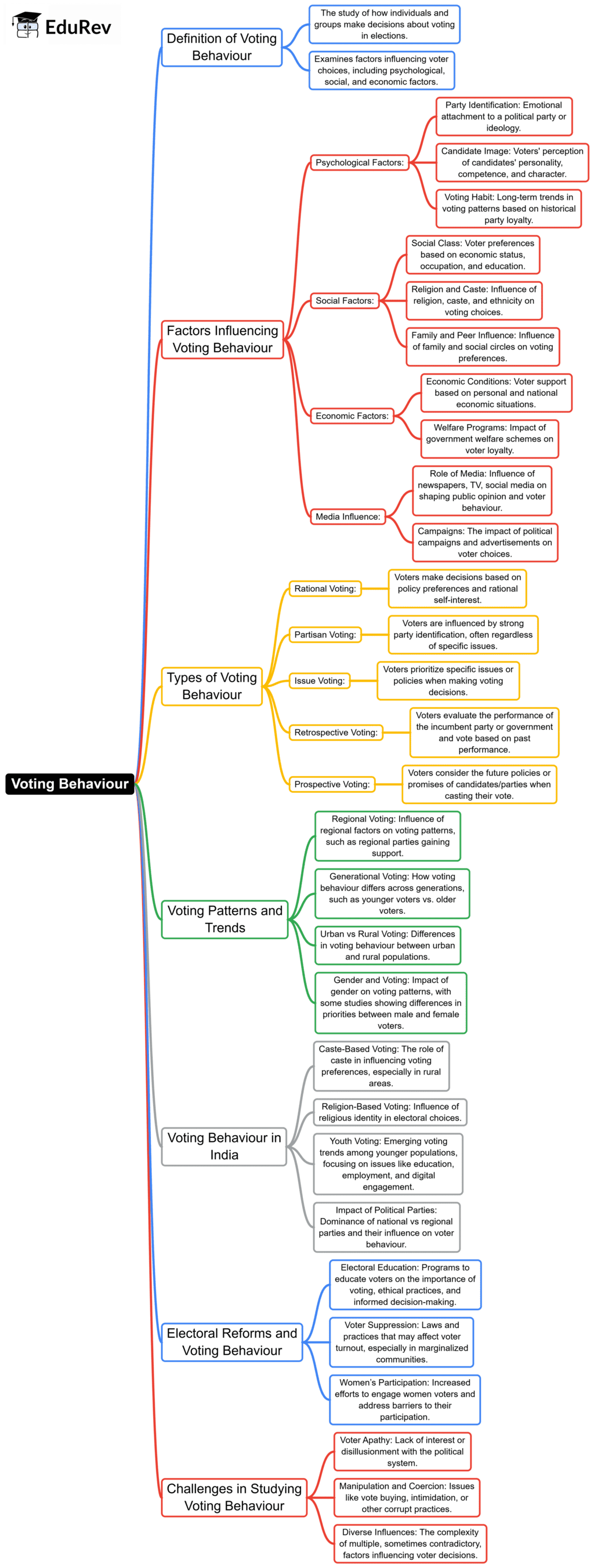UPSC Exam > UPSC Notes > Indian Polity for UPSC CSE > Mind Map: Voting Behaviour
Mind Map: Voting Behaviour | Indian Polity for UPSC CSE PDF Download

The document Mind Map: Voting Behaviour | Indian Polity for UPSC CSE is a part of the UPSC Course Indian Polity for UPSC CSE.
All you need of UPSC at this link: UPSC
|
154 videos|998 docs|260 tests
|
FAQs on Mind Map: Voting Behaviour - Indian Polity for UPSC CSE
| 1. What factors influence voting behavior in elections? |  |
Ans. Voting behavior is influenced by a variety of factors including socio-economic status, education level, age, gender, and ethnicity. Additionally, psychological factors such as party identification, political ideology, and the impact of media can also play significant roles. Voters may be swayed by the candidates' campaign strategies, their personal experiences, and the prevailing political climate, which includes public opinion on key issues.
| 2. How does party affiliation affect voter turnout? |  |
Ans. Party affiliation is a strong predictor of voter turnout. Individuals who strongly identify with a political party are more likely to participate in elections compared to those who do not have a party affiliation or who are independents. The sense of belonging to a party can motivate individuals to engage in the electoral process, as they feel their vote contributes to the party's success. Moreover, parties often mobilize their members through various means such as voter registration drives and get-out-the-vote efforts.
| 3. What role do socio-economic factors play in determining voting behavior? |  |
Ans. Socio-economic factors such as income, occupation, and educational attainment significantly influence voting behavior. Generally, individuals from higher socio-economic backgrounds tend to vote more frequently and may lean toward certain political parties that align with their interests. Conversely, lower socio-economic groups may face barriers to voting, such as lack of access to information or polling places. Economic issues, including employment and welfare policies, also play a critical role in shaping the political preferences of different socio-economic groups.
| 4. How does media influence public opinion and voting behavior? |  |
Ans. Media plays a crucial role in shaping public opinion and influencing voting behavior through the dissemination of information about candidates, political parties, and issues. The way news is reported can affect perceptions and attitudes towards candidates, potentially impacting voter decisions. Social media platforms have further transformed this landscape by allowing for targeted campaigning and the rapid spread of information (and misinformation), which can significantly sway public opinion leading up to elections.
| 5. What is the impact of demographic changes on voting patterns? |  |
Ans. Demographic changes, such as shifts in age, race, and immigration patterns, can have a profound impact on voting patterns. As different demographic groups grow or decline in population, their political preferences can reshape electoral outcomes. For example, younger voters may prioritize issues like climate change and social justice, while older voters may focus on economic stability and healthcare. Understanding these demographic trends is crucial for political parties aiming to connect with and mobilize various voter segments effectively.
Related Searches





















